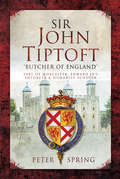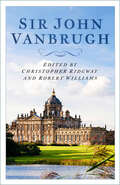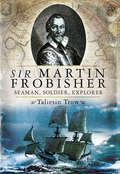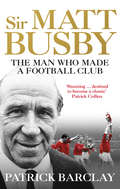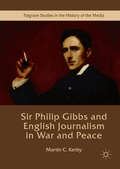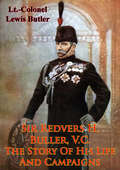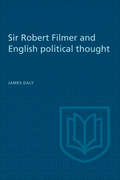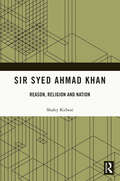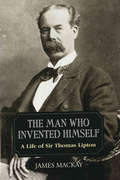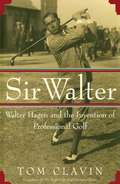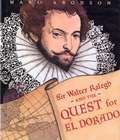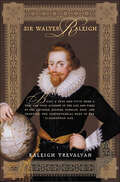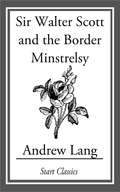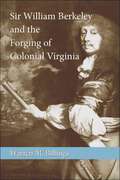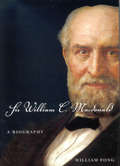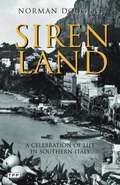- Table View
- List View
Sir John Moore: The Making of a Controversial Hero
by Janet MacdonaldSir John Moore is perhaps the second most famous British soldier of the Napoleonic Wars after the Duke of Wellington, yet his remarkable career has been neglected in comparison to his celebrated contemporary. His death in battle at Corunna overshadows the wide range of his earlier campaigns and his achievements as an innovative soldier. Janet Macdonalds fluently written and insightful biography focuses on the development of his character as well as his career as a commander. From it emerges a many-sided portrait of a fascinating man and an outstanding soldier, a key figure in the history of the British army. Admired by his peers but distrusted by his political masters, Moore was a controversial figure. He is best known for saving the British army in Spain by leading the retreat to Corunna, but he is also credited with developing the training system that enabled Wellingtons army to beat the French in Spain and at Waterloo. Janet Macdonalds account will rekindle interest in a leading actor in the struggle against the French revolutionary and Napoleonic armies.
Sir John Tiptoft: Earl of Worcester, Edward IV's Enforcer and Humanist Scholar
by Peter SpringJohn Tiptoft, Earl of Worcester, is arguably the most intriguing, controversial and possibly misunderstood figure of the Wars of the Roses period. Politically adept, he occupied a string of important offices, first under the Lancastrian Henry VI and then the Yorkist Edward IV.A man of action, he held commands on both and sea, in England, Ireland and Wales.As Constable of England he acted as Edwards enforcer and earned the sobriquet Butcher of England for his beheadings and impalements. Yet he was also an outstanding Renaissance scholar who studied at Oxford, Padua and Ferrara, a collector of books and patron. This, in conjunction with his political actions, makes him a proto-Machiavellian Prince.Peter Spring also looks beyond the Earls public life to glean insights into the man himself, concluding that the available information generally reveals an attractive personality. He presents a balanced reappraisal, seeing him, as did many contemporary Europeans and some fellow countrymen, as a man of great intellect and capability who did not shirk the hard tasks imposed by a merciless age.Worcesters execution for the application of Roman law, lampooned as the laws of Padua, demonstrated the danger of indentification with continental influences in an England increasingly defining itselfthrough common law, Parliament, and soon religionagainst Europe. The contemporary denigration of his character by little Englander chroniclers reflected a deepening antipathy towards the cosmopolitan a recurring trait in the English character perhaps re-emerging with Brexit.
Sir John Vanbrugh and Landscape Architecture in Baroque England
by Robert Williams Christopher RidgwaySir John Vanbrugh is celebrated today as one of England's finest country house architects. His masterpieces include palatial private homes such as Castle Howard and Blenheim Palace, greatly admired by any enthusiast of English Baroque architecture. However, his work extended far beyond such projects, and included a remarkable variety of temples, belvederes, pyramids and many other features which he designed for the gardens and parks of the estates at which he worked.The originality of such work has shown that Vanbrugh played a crucial role in the development of the eighteenth-century English garden, and this unique and fascinating book uses the fruits of new research to assess just what contribution this great man made to our heritage.
Sir Lewis
by Michael SawyerAn inspiring biography of Formula One driver Lewis Hamilton's epic rise to glory, from his racing career and beyond. Formula One driver Lewis Hamilton&’s journey from remote-controlled car hobbyist to seven-time world champion, knight of the realm, and global superstar is the stuff of sporting legend. This authoritative biography follows Hamilton&’s path from his early days karting on local tracks to the glitz and pressure of the Formula One circuit. Along the way, we witness Hamilton&’s single-minded determination to reach the top, even as he challenged racial barriers and opposition at every turn. His triumph over adversity is all the more inspiring, given Hamilton&’s pioneering role in making motorsports accessible to marginalized communities. Beyond his unparalleled on-track exploits—leveling the record books held by the legendary Michael Schumacher—Hamilton has used his platform to advocate for social justice, environmental sustainability, and diversity. Hamilton has leveraged his fame to push Formula One and global sports to be a force for positive influence while inspiring a new generation of athletes and artists to pursue their dreams. As Hamilton nears the twilight of his racing career, this thoroughly researched book examines his lasting legacy. His impact extends far beyond just his championship trophies. Sir Lewis culminates with Hamilton&’s potential final act—chasing a record-setting 8th world title at the wheel of the iconic Ferrari team, the ultimate validation of his greatness.
Sir Martin Frobisher: Seaman, Soldier, Explorer
by Taliesin TrowSir Martin Frobisher was one of the great sea dogs of Elizabethan England. He was a pirate and a privateer - he looted countless ships and was incarcerated by the Portuguese as a young man - and he aided Sir Francis Drake in one of his most daring voyages to attack the Spanish in the West Indies. But Frobisher was also a warrior who was knighted for his services against the Spanish Armada, and he was an explorer. He was the first Englishman to attempt to find the fabled Northwest Passage to Cathay to China. He commanded three voyages into the uncharted northern wastes Canada and Greenland and devoted eighteen years of his life to this dream. Taliesin Trows new biographical study of this many-sided Elizabethan adventurer should revive interest in him and in this extraordinary period in English seafaring history. For Frobisher was a fascinating, enigmatic character whose reputation is often eclipsed by those of his remarkable contemporaries, Drake, Hawkins and Ralegh.
Sir Matt Busby: The Definitive Biography
by Patrick BarclayThe Man Who Made A Football ClubSir Matt Busby, who took Manchester United to unprecedented glory before seeing the club through profound tragedy, created the global entity that spreads from Old Trafford today.A player with Manchester City and Liverpool before the Second World War, Busby remained at the forefront of football through four decades and made an extraordinary contribution to the game in terms of both style and substance. In this definitive biography, Patrick Barclay looks back at Busby’s phenomenal life and career, including the rise of the Busby Babes in the 1950s, the Munich disaster that claimed 23 lives and the Wembley victory ten years on that made United the first English team to win the European Cup. Denis Law, Pat Crerand and such other members of that great side as Alex Stepney, David Sadler and John Aston are among the host of voices testifying to the qualities that set Sir Matt apart.This is the story of one of the greatest figures in football history, and of the making of a legacy that will last for ever.
Sir Norman Angell
by Albert MarrinToward the end of his life, the octogenarian Norman Angell looked back despondently upon fifty years of toil and sacrifice on behalf of world peace. He had served the cause well: as author of The Great Illusion, one of the seminal works of the twentieth century; as a founder of the Union of Democratic Control; as foreign policy advisor to the Labour party; as a winner of the Nobel Peace Prize and proponent of the League of Nations, disarmament, and collective security.
Sir Oliver Mowat
by A. Margaret EvansFew political leaders in Ontario's history have had as lasting an impact on the province, and perhaps on the nation, as Oliver Mowat, premier from 1872 to 1896. Under his leadership Ontario flourished economically, socially, and politically. Among the many political skills that Mowat brought to office, one of the most useful was pragmatism. He was able to establish a rock-solid style that appealed to a wide spectrum of the electorate: rural and urban, Catholic and Protestant. He was also adept at redrawing constituency boundaries and extending the franchise at opportune times. Margaret Evans's biography of Mowat is in some ways the story of a golden age in the province's history. During this period Ontario modernized agriculture and industry, opened the north, developed natural resources, addressed social problems, and accepted trade unions. Above all, it established itself as the dominant province in Confederation. This last was accomplished through a stubborn struggle with Ottawa. John A. Macdonald fought hard against Mowat's provincial-rights moves, and referred to the premier as 'the little tyrant.' But Mowat prevailed. The Canada that emerged was a less centralized state than Macdonald had ever wanted; the provinces had substantially more power. A century later, that legacy of diffused power has been at the centre of much of Canada's constitutional debate.
Sir Philip Gibbs and English Journalism in War and Peace
by Martin C. KerbySir Philip Gibbs was one of the most widely read English journalists of the first half of the twentieth century. Prior to 1914 he reported on industrial unrest, Ireland, the suffragette movement, royal births, deaths and coronations, the sinking of the Titanic, and the Balkan War in 1912. This coverage of his writing offers a broad insight into British social and political developments, government and press relations, propaganda, and war reporting during the First World War. As a war correspondent on the Western Front, his articles, which appeared on both sides of the Atlantic, did much to shape civilian attitudes during the First World War and its immediate aftermath. Many critics dismissed Gibbs' work as propaganda and his acceptance of a knighthood in 1920 as a reward. His writing in the post-war years covered the full range of inter-war European politics, the Second World War, and the Cold War.
Sir Redvers H. Buller, V.C.: The Story Of His Life And Campaigns
by Lt.-Colonel Lewis William George ButlerGeneral Sir Redvers Buller V.C. was among the most popular generals of his age, born in 1839 he was commissioned into the 60th Rifles in and started a military career that would last 40 years.His postings were many and varied; China in 1860, before many years in Canada and a distinguished part in the Red River expedition under Sir Garnet Wolseley in 1870 and under the same commander in the Second Ashanti War 1873-74. His next active command would earn him a Victoria Cross during the Anglo-Zulu war of 1879 at the head of the mounted infantry of Sir Evelyn Wood's No. 4 Column. During the bloody defeat at Hlobane, Buller rallied the demoralized retreating rearguard, and rode back in the face of the hotly pusuing Zulu warriors to rescue men who had been unhorsed, not once, twice but three times! As if this was not enough the next day he fought at the victorious at the battle of Kambula, and later at the decisive battle of Ulundi. Buller left Africa a hero among his men and respected by his peers.His final command, during the Second Anglo-Boer War was much less successful; sent out to command and retrieve a situation already bungled, at the age of sixty, despite his protests. Facing a guerrilla war he instituted new tactics that would become standard practice to the modern day; use of cover, fire and movement, creeping barrages. However, these innovations were not enough to bridge the gap between his opponents and his hidebound troops, and he suffered a number of high profile defeats.
Sir Robert Falconer: A Biography
by James G. GreenleeBiblical scholar, social critic, and internationalist, Robert Alexander Falconer was also the foremost Canadian university leader of his generation, serving as president of the University of Toronto from 1907 to 1932. James Greenlee's biography chronicles his development as an academic leader and a public man.
Sir Robert Filmer and English Political Thought
by James DalySir Robert Filmer (1588-1653) was a defender of 'the Natural Power of Kings against the Unnatural Liberty of the People.' His doctrine of omnicompetent sovereignty had little influence on the thought and political debates of his time, for none of his writings was published until the last few years of his life; but it came under scrutiny later in the century, particularly during the exclusion crisis and in the political writings of John Locke. This book is the first comprehensive analysis of his thought, its context, and its place in English political thought as a whole. Daly examines Filmer's publishing career, his relation to contemporary writers and critics, and the chief sources on which he drew. The book thus provides the background for a study of Filmer's theory of sovereignty, its voluntarist concept of law, its rejection of prescription, fundamental law, and non-monarchical forms of government, and its insistence that monarchy be not only absolute, but arbitrary as well. Analysing Filmer's interpretation of Adam's (and all kings') 'fatherly power,' here described as 'legal patriarchalism,' Daly shows it to be very different from most contemporary thought. In comparing Filmer's thought with that of other royalists and the positions taken by his critics, notably Edward Gee, James Tyrrell, Algernon Sidney, and of course Locke, he shows it to be strikingly original, almost revolutionary, and frequently distorted by those who dealt with it.
Sir Rutherford Alcock: First British Minister to Japan (1859-1865), Consul (1844-1859) and Minister (1865-1870) to China
by Robert MortonThe son of a village doctor, Rutherford Alcock trained in medicine and became a battlefield surgeon, working in Portugal and Spain during the civil wars there in the 1830s. In a major career shift, he entered the consular service, went to China, and ended up as British Minister (the equivalent of today’s ambassador) to Japan and then China. This progression was unique, indeed bizarre, especially as every senior position he got was one he specifically said he did not want. Nonetheless, he was the man who commenced Britain’s relations with Japan and introduced Japan’s arts and crafts to the UK, in addition to playing a central role in Britain’s relationship with China. He was no rampant imperialist and expressed ambivalence about Britain’s position in East Asia as he contended with intractable issues like the opium trade and how to punish attacks on British interests without starting a war. This book fills a major gap in the study of Japan’s opening to the West from a British perspective, as well as Britain’s relationship with East Asia as a whole, through the eyes of a brilliant, but complicated and contradictory figure.
Sir Sandford Fleming: His Early Diaries, 1845-1853
by Jean Murray ColeSandford Fleming knew fame and many honours later in life, but the path was not always easy. His beginnings are revealed in these early diaries that record his thoughts as an eighteen-year-old leaving his family home in Scotland for Canada. After unsuccessful attempts to get work as a surveyor, he finally made important contacts in Toronto, and through involvement with the Mechanics’ Institute and the (Royal) Canadian Institute, became connected to the leading architects and engineers in the community. His work on major projects, including an ambitious plan for the Toronto Harbour and The Esplanade, ultimately led to his first big railway appointment in 1852. Best known for his role in mapping the Canadian Pacific Railway, he also designed Canada’s first adhesive postage stamp, the three-penny Beaver; was an early promoter of the Pacific cable; and is recognized around the world as the inventor of Standard Time. The recipient of many honours, Fleming was knighted by Queen Victoria in 1897.
Sir Syed Ahmad Khan: Reason, Religion and Nation
by Shafey KidwaiThis book presents a nuanced narrative on Sir Syed Ahmad Khan’s (1817–1898) life and his invaluable contribution to the democratic consciousness in India. Based on extensive archival research and a close study of his writings, speeches, and addresses, it explores the life and works of Sir Syed in the broader context of socio-political debates in nineteenth-century India. A seminal figure who shaped modern India, Sir Syed Ahmad Khan is known as the pioneer of modern education among the Muslims in India. Reconciling faith with demonstrable truths, he contributed immensely as a member of the several apex bodies such as Vice-Regal Legislative Council, Royal Public Service Commission, Royal Education Commission, and Legislative Council of North West Provinces. The volume also explores the reformer’s views on issues like colonial law and administration, the concept of blasphemy, conversion, female education, religious beliefs, freedom of press, emancipation of women, Hindu–Muslim unity, Urdu–Hindi controversy, and reservation for Muslims. Thoughtfully and incisively written, this volume will be of great interest to scholars and researchers of modern India, Indian political thought, political philosophy, education, political science, colonial history, Islamic Studies, religious studies, Islamic law, biography, and South Asian studies.
Sir Thomas Lipton: The Man Who Invented Himself
by Dr James MackayThomas Lipton burst onto the national scene in 1897, the year of Queen Victoria's Diamond Jubilee. The Princess of Wales had launched a £30,000 fund to provide a Jublilee dinner for the poor, but, with only weeks to go, no more than £5,000 had been subscribed. Lipton saved the day by writing a cheque for £25,000. The annonymous gift created massive press speculation and even greater publicity when the identity of the donor leaked out two days later. Lipton's generosity earned him a knighthood and propelled him into society at the highest level, a personal friend of the future King and Queen.Many of the myths that surrounded Lipton in the latter part of his life were created at this time and would be fixed for ever in his autobiography, published shortly after his death in 1931. Until now, what we know of Sir Thomas Lipton, grocery millionaire and yachtsman, is what he chose to tell the world about himself. Now literally detective James Mackay has uncovered the true story of one of the turn of the century's most extrordinary, larger-than-life characters, a story which is indefinitely more dramatic than the accepted version.Virtually everything Lipton tells us about himself is now shown to be untrue - even the origins of his family, his name, his date of birth and the place where he was born. The man who was hailed as the world's most eligible bachelor (his name was linked romantically with Rose Fitzgerald, the future mother of John F. Kennedy) had at least two skeletons in the closet - a youthful indescretion which led to a forced marriage, and a homosexual affair which lasted for thirty years.As a self-publicist he was a genius, and this was the key to his remarkable success. Beginning with a small shop in Glasgoe in 1871 he created a nationwide grocery chain second to none. In the process, he revolutionised the grocery retail trade, dealing direct with producers and eventually controlling production himself, with tea estates in Ceylon and meat-packing plants in Chicago. He combined a flair for organisation with superb showmanship, with stunts such as five-ton cheeses stuffed with gold sovereigns. In 1898 his company went public in one of the most successful share issues in stockmarket history.Lipton developed an interest in yachting which he pursued with the same single-mindedness as his business ventures. Between 1898 and 1930 he challenged for the America's Cup with a succession of yachts called Shamrock, but the rules of the race were heavily weighted in favour of the American defenders. The saga of his challenges, his near triumphs and the disappointments that would have destroyed a less heroic figure has become the most stirring in the annals of sport, and provides a fitting conclusion to the life of a maverick and outsider who was also one of the most colourful and flamboyant tycoons of all time.
Sir Vidia's Shadow: A Friendship Across Five Continents
by Paul TherouxThe acclaimed writer shares an intimate portrait of his former mentor V.S. Naipaul in this memoir of their thirty-year friendship and sudden falling out.Paul Theroux was a young aspiring writer when he met the legendary V.S. Naipaul in Uganda in 1966. There began a friendship that would span continents as both men ascended the ranks of literary stardom. Naipaul’s early encouragement of Theroux’s talent had a profound impact on him—yet the apprenticeship was not always easy.This heartfelt and revealing account of Theroux's thirty-year friendship with Naipaul explores the unique effect each writer had on the other. Built around exotic landscapes, anecdotes that are revealing, humorous, and melancholy, and three decades of mutual history, this is a personal account of how one develops as a writer and how a friendship waxes and wanes between two men who have set themselves on the perilous journey of a writing life.A New York Times Notable Book
Sir Walter
by Tom ClavinDuring the Golden Age of Sports in the 1920s, Walter Hagen was to golf what Babe Ruth was to baseball. The first professional golfer to make his living playing the game rather than teaching it, Hagen won eleven major professional tournaments over his long career -- two U.S. Opens, four British Opens, and five PGA Championships (including an amazing streak of four consecutive PGA wins) -- a record surpassed only by Jack Nicklaus. Hagen was also influential in helping to found the Ryder Cup and was the first American golfer to top $1 million in career earnings -- a figure equivalent to over $40 million today. Award-winning sportswriter Tom Clavin has penned a thrilling biography that vividly recalls Hagen's dazzling achievements and the qualities that made him a star. Energetic, witty, and one of the best putters ever to walk the green, Hagen was a man who loved to party, was extraordinarily generous to his friends, and golfed the world over, giving exhibitions. He preferred to travel by limousine, and if he intended to stay awhile he'd bring a second limo just to transport his clothes, which were nothing but the finest. On his many trips across the Atlantic to compete in the Ryder Cup or British Open, Hagen was known to throw parties that lasted days, ending only when the ship reached the shore. He was also the first professional golfer to admit to playing not only for the love of the game, but also for the love of the winner's purse. Walter Hagen, forerunner of today's sports superstars, is as dynamic a character as can be found in American sports history. Bringing Hagen to life with incredible detail and countless anecdotes, Sir Walter is the authoritative biography of the man who helped create professional golf as it's known today.
Sir Walter Ralegh and the Quest for El Dorado
by Marc AronsonSir Walter Ralegh played the starring role in a life that was a series of romantic, almost-too-spectacular-to-be-true adventures. From the dazzling court of Queen Elizabeth to the dense jungles of South America, from daring sea raids to the epic struggle against the Spanish Armada, from his luminous historical writings to his intimate poetry, Ralegh left his mark on the age. His life was as dramatic and complex as a Shakespearean play.<P><P> Ralegh was a man of great contradictions: He participated in the massacre of Catholics in Ireland, yet later supported religious toleration; he was a calculating courtier resented by many, yet he spoke so eloquently for the rights of individuals that he became a popular hero. His quest to find the legendary city of El Dorado and the fate of the famous Lost Colony he had sponsored in the New World are representative of both the soaring hopes and nightmarish realities that Europeans brought with them across the seas.<P>In this extraordinarily well researched biography, Marc Aronson passionately reveals the charisma and bravery of a man whose personality could not have been better suited to his era, a time filled with political intrigue, fierce battles, and courageous souls questing after impossible dreams.<P> Winner of the Sibert Medal
Sir Walter Raleigh: Being A True And Vivid Account Of The Life And Times Of The Explorer, Soldier, Scholar, Poet, And Courtier--the Controversial Hero Of The Elizabethian Age
by Raleigh TrevelyanAn enthralling new biography of the most exciting and charismatic adventurer in the history of the English-speaking worldTall, dark, handsome, and damnably proud, Sir Walter Raleigh was one of history's most romantic characters. An explorer, soldier, courtier, pirate, and poet, Raleigh risked his life by trifling with the Virgin Queen's affections. To his enemies—and there were many—he was an arrogant liar and traitor, deserving of every one of his thirteen years in the Tower of London.Regardless of means, his accomplishments are legion: he founded the first American colony, gave the Irish the potato, and defeated Spain. He was also a brilliant operator in the shark pool of Elizabethan court politics, until he married a court beauty, without Elizabeth's permission, and later challenged her capricious successor, James I. Raleigh Trevelyan has traveled to each of the principal places where Raleigh adventured—Ireland, the Azores, Roanoke Islands, and the legendary El Dorado (Orinoco)—and uncovered new insights into Raleigh's extraordinary life. New information from the Spanish archives give a freshness and immediacy to this detailed and convincing portrait of one of the most compelling figures of the Elizabethan era.
Sir Walter Scott and the Border Minstrelsy
by Andrew LangAndrew Lang (1844-1912) was a prolific Scots man of letters, a poet, novelist, literary critic and contributor to anthropology. He now is best known as the collector of folk and fairy tales. He was educated at the Edinburgh Academy, St Andrews University and at Balliol College, Oxford. As a journalist, poet, critic and historian, he soon made a reputation as one of the ablest and most versatile writers of the day. Lang was one of the founders of the study of "Psychical Research," and his other writings on anthropology include The Book of Dreams and Ghosts (1897), Magic and Religion (1901) and The Secret of the Totem (1905). He was a Homeric scholar of conservative views. Other works include Homer and the Epic (1893); a prose translation of The Homeric Hymns (1899), with literary and mythological essays in which he draws parallels between Greek myths and other mythologies; and Homer and his Age (1906). He also wrote Ballades in Blue China (1880) and Rhymes la Mode (1884).
Sir William Berkeley and the Forging of Colonial Virginia (Southern Biography Ser.)
by Warren M. BillingsSir William Berkeley (1605--1677) influenced colonial Virginia more than any other man of his era, diversifying Virginia's trade with international markets, serving as a model for the planter aristocracy, and helping to establish American self-rule. An Oxford-educated playwright, soldier, and diplomat, Berkeley won appointment as governor of Virginia in 1641 after a decade in the court of King Charles I. Between his arrival in Jamestown and his death, Berkeley became Virginia's leading politician and planter, indelibly stamping his ambitions, accomplishments, and, ultimately, his failures upon the colony. In this masterly biography, Warren M. Billings offers the first full-scale treatment of Berkeley's life, revealing the extent to which Berkeley shaped early Virginia and linking his career to the wider context of seventeenth-century Anglo-American history.
Sir William C. Macdonald
by William FongBorn into a prominent Scottish family on Prince Edward Island, Macdonald rejected his Catholic upbringing and left home when he was eighteen. After three years in Boston as a bookkeeper he headed to Montreal and began to work as a commission agent. By 1868 Macdonald had become the leading manufacturer of chewing tobacco in Canada, and by 1885 he may have been the richest person in the country.
Siren Land: A Celebration of Life in Southern Italy (Tauris Parke Paperbacks Ser.)
by Norman DouglasNorman Douglas’s first travel book, Siren Land is an homage to a part of the world that captivated the author more than any other. Weaving the myths of the Sirens into the landscape and history of the region, Douglas writes with knowledge and an irrepressible exuberance of the past and the present, of legends and archaeology, folklore and daily life, patron saints, local ghosts, wine, and the wind.
Siren Song: My Life in Music
by Seymour Stein Gareth MurphyThe autobiography of America’s greatest record man: the founder of Sire Records and spotter of rock talent from the Ramones to Madonna.Seymour Stein was America's greatest record man. Not only did he sign and nurture more important artists than anyone alive, after over sixty years in the game, he was still the hippest label head, travelling the globe in search of the next big thing. Since the late fifties, he had been wherever was happening: Billboard, Tin Pan Alley, The British Invasion, CBGB, Studio 54, Danceteria, the Rock n Roll Hall of Fame, the CD crash. Along that winding path, he discovered and broke out a skyline full of stars: Madonna, The Ramones, Talking Heads, Depeche Mode, Madonna, The Smiths, The Cure, Ice-T, Lou Reed, Seal, and many others.Brimming with hilarious scenes and character portraits, Siren Song’s wider narrative is about modernity in motion, and the slow acceptance of diversity in America – thanks largely to daring pop music. Including both the high and low points in his life, Siren Song touches on everything from his discovery of Madonna to his wife Linda Stein's violent death.Ask anyone in the music business, Seymour Stein was a legend. Sung from the heart, Siren Song will etch his story in stone.

